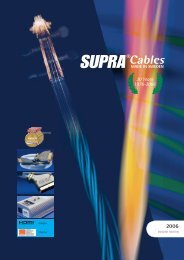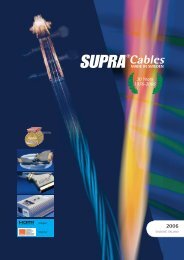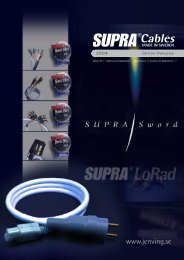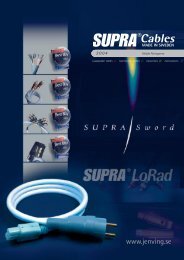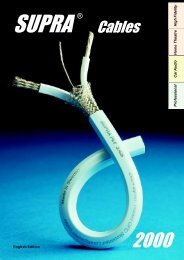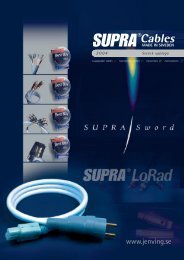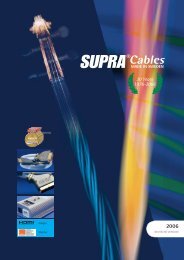English Edition High Fidelity Car A udio Professional ... - Supra cables
English Edition High Fidelity Car A udio Professional ... - Supra cables
English Edition High Fidelity Car A udio Professional ... - Supra cables
Create successful ePaper yourself
Turn your PDF publications into a flip-book with our unique Google optimized e-Paper software.
SUPRA ® 4<br />
Ply Loudspeaker Cables<br />
Hi-Fi<br />
Ply 2.0 Actual size Ply 3.4<br />
Actual size<br />
Item<br />
Conductor<br />
Before considering more special ’esoteric’<br />
2nd and 3rd-order effects, such as<br />
conductor metallurgy, the performance of<br />
a<strong>udio</strong> <strong>cables</strong> is principally determined by their<br />
series loop resistance (R), their series loop<br />
inductance (L) and their shunt capacitance<br />
(C). Both the absolute and the relative values<br />
of R, L & C matter. For speaker <strong>cables</strong><br />
connecting high performance amplifiers to<br />
every day electrodynamic (moving coil or<br />
ribbon) speaker drive-units that are desired<br />
to operate with fidelity across the a<strong>udio</strong><br />
band, the R & L (cable resistance &<br />
inductance) must both be low, while the<br />
value of C (capacitance) does not matter<br />
much [1,2]. This is so because current flow<br />
into conventional speaker drive-units is<br />
relatively so much larger than in line-level<br />
connections, and also absolutely large,<br />
ranging to over 100 Amperes in some<br />
instances. This is especially true of auto (12<br />
volt) installations. But simply using a fat wire<br />
gauge makes R low at the expense of<br />
increasing L. This is musically unacceptable<br />
for high sonic quality.<br />
’Squaring the circle’ techniques to make this<br />
loop inductance, L, low, simultaneous with<br />
low resistance, include tapes, either stacked<br />
in parallel pairs, or several arranged side-byside<br />
in ribbons, where the ends are X-<br />
connected. But of course, these types are (i)<br />
impractical to fit to nearly every known<br />
speaker connector (at least without<br />
introducing discontinuities), (ii) are stressed<br />
Mechanical Specifications<br />
Cross Sec. Area<br />
(mm²/AWG)<br />
Insulation Jacket External<br />
Size (mm)<br />
Colour<br />
<strong>Supra</strong> Ply, a Logical and Scientific Design<br />
and may be unsightly when right angle<br />
surface bends are required in domestic<br />
installation, and (iii) are unsuited to for<br />
mobile use by professionals. Litz<br />
techniques, i.e. multiple, parallel, insulated<br />
conductors are more practical in use and<br />
laying out, but when properly executed,<br />
they are expensive.<br />
They are also awkward to terminate and<br />
must be soldered. Other types are grossly<br />
large, like industrial pneumatic pipes, making<br />
them unsuited to smaller domestic<br />
dwellings.<br />
Conventionally, fat conductors’ high loop<br />
inductance (which raises impedance at<br />
+6dB/octave) is further raised due to<br />
internal eddy currents causing ’Skin effect’.<br />
This acts like ’the square root of an<br />
inductor’, i.e. progressively adds a +3dB/<br />
octave component to the cable’s series<br />
inductance. With typical speaker cable runs<br />
of a few metres, the combined inductive<br />
effect is that performance in moderately<br />
heavy, plain conductors is measurably<br />
affected with steady signals at or a little<br />
above 1kHz. Whereas for music transients,<br />
even low bass qualities are affected.<br />
Conventional stranded <strong>cables</strong> with copper,<br />
silver or related conductors suffer from<br />
complex oxidation. The surface becomes a<br />
semiconductor. The diodes so formed<br />
between the strands are not seen by<br />
steady-state signals, but look like the plates<br />
of a high value capacitor to transient<br />
Weight<br />
(g/m)<br />
Length/ bobbin<br />
(m / ft)<br />
Elec. Specifications<br />
Resistance Inductance<br />
(Ω/km) (µH/m)<br />
Ply 2.0 2x120x0.15 OFC, Sn 2x2.0 / 14 AWG Chloride Ion-<br />
6.1x4.9 Ice 73 100m / 328ft 8.1 0.30<br />
PVC<br />
Ply 3.4 2x192x0.15 OFC, Sn 2x3.4 / 12 AWG Stab. PVC<br />
7.0x7.0 Blue 104 100m / 328ft 5.1 0.20<br />
signals. This causes low-level energy<br />
storage and release after transients, that is<br />
invisible to steady state testing yet nonetheless<br />
perfectly audible with many music<br />
recordings. This ’transversal distortion’ may<br />
also be described in terms of the TEM<br />
(Transverse Electro-Magnetic) Wave,<br />
which takes a direct route, whereas<br />
electron flow is ’trapped’ inside individual,<br />
particular strands that are commonly<br />
twisted away from the most direct route, at<br />
each of the inevitable bends in a stranded<br />
cable, when laid-out.<br />
<strong>Supra</strong> Ply is able to be a large-section, low<br />
resistance cable, while also overcoming<br />
skin effect and transversal distortion, by<br />
using a proprietary, pure tin plating. This<br />
has the double benefit that tin and copper<br />
meld without forming a diodic barrier (as<br />
with many silver-plated copper ’a<strong>udio</strong>grade’<br />
conductors) and that tin strongly resists<br />
most common causes of metal corrosion,<br />
and hermetically protects the copper,<br />
making <strong>Supra</strong> Ply ideal for outdoor use.<br />
By contrast, most a<strong>udio</strong>grade <strong>cables</strong><br />
claiming highly pure copper or silver<br />
conductors are either wholly unprotected<br />
from contamination, initially by the outgassing<br />
of the plastic covering (even if<br />
PTFE/Teflon), and eventually from the<br />
impure atmosphere - and even from<br />
accidental immersion in liquids! Some very<br />
expensive <strong>cables</strong> are protected only by a<br />
very thin, initially good lacquer, that must



